Magical
Thought and the Digital Reconstruction of New York
by Rogelio Villarreal
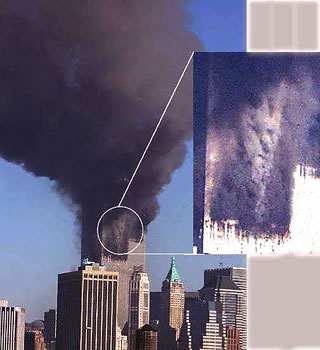
Some people
thought they saw the devil's face in this image.
Past and Present: From Aztlan to New York
Before the arrival of the Spanish conquistadors to Middle America, several strange portents had already given word of their existence: comets, flashes of lightning, fires, idols that conveyed ill-fated messages, demons that warned of an imminent tragedy, two-headed men, people who spoke in trance, rare multicolored bird specimens, and mirrors hidden in mysterious caves. Thus, to understand the catastrophe of the present, Montezuma and his priests turned to history to find the explanation to what was happening. But, as Tzvetan Todorov suggests in The Conquest of America:
 The omens of Moctezuma. Sighting of thecomet. |
Everything
would lead us to believe that the portents were invented after the
fact; but, why? […] Instead of conceiving the event as a purely
human, although admittedly unparalleled, encounter–the arrival
of men who were hungry for gold and power–the natives assimilated
it within a network of natural, social and supernatural relations
where the event abruptly loses its singularity: in a certain sense,
it becomes domesticated, absorbed by an already existing order of
beliefs. The Aztecs were able to perceive the conquest, that is,
the defeat, and at the same time overcome it by integrating it into
a history conceived in accordance to their own demands […]:
The present becomes intelligible and at the same time less inadmissible
the moment we are able to see it already foretold in the past.(1)
|
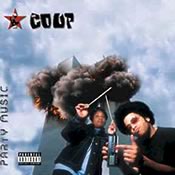 Besides
the fact that some important events seem to have been prefigured by preceding
signs of forewarning, as if we were dealing with reticent and erratic
warnings that escape the future to caution us now, in the fleeting present,
it is significant to note that this kind of magical reasoning still survives
in the rational world so dear to the West. A similar phenomenon to that
of the omens among the Aztecs, could be observed after the suicide attacks
on the Twin Towers (how distant that event seems now!), including certain
signs that in retrospective could have foreshadowed the tragedy: the numerous
allusions to terrorist or outer-space attacks on the United States in
movies, or the album by the hip-hop group The Coup which showed
on its cover the two rappers joking in front of an exploding World Trade
Center (the album was pulled from stores, and scenes with imposing buildings
were cut or replaced in several movies which had not yet been released).
Even if we regard the Aztec's way of thinking as passive because of its
tacit acceptance of the inescapable nature of the invasion and conquest,
the attitude of New Yorkers and Americans in general is not less magical,
in spite of having been created and encouraged by film imagery and by
the belligerent official discourse that sees the United States, ever since
it was founded, as the strongest and most righteous country in history.
Hence their inability to envisage an act of extreme hatred aimed at their
civilization. Hence the ferocity of their response to Afghanistan and
the arrogant reiteration of their supremacy over the world. The magical
frame of mind of the Mesoamericans helped them to sublimate the defeat
in terms of a past that predicted a thorny, yet inescapable future. The
magical thought of the Americans made them overcome the greatest tragedy
in their history for the sake of their dominance over the rest of the
world.
Besides
the fact that some important events seem to have been prefigured by preceding
signs of forewarning, as if we were dealing with reticent and erratic
warnings that escape the future to caution us now, in the fleeting present,
it is significant to note that this kind of magical reasoning still survives
in the rational world so dear to the West. A similar phenomenon to that
of the omens among the Aztecs, could be observed after the suicide attacks
on the Twin Towers (how distant that event seems now!), including certain
signs that in retrospective could have foreshadowed the tragedy: the numerous
allusions to terrorist or outer-space attacks on the United States in
movies, or the album by the hip-hop group The Coup which showed
on its cover the two rappers joking in front of an exploding World Trade
Center (the album was pulled from stores, and scenes with imposing buildings
were cut or replaced in several movies which had not yet been released).
Even if we regard the Aztec's way of thinking as passive because of its
tacit acceptance of the inescapable nature of the invasion and conquest,
the attitude of New Yorkers and Americans in general is not less magical,
in spite of having been created and encouraged by film imagery and by
the belligerent official discourse that sees the United States, ever since
it was founded, as the strongest and most righteous country in history.
Hence their inability to envisage an act of extreme hatred aimed at their
civilization. Hence the ferocity of their response to Afghanistan and
the arrogant reiteration of their supremacy over the world. The magical
frame of mind of the Mesoamericans helped them to sublimate the defeat
in terms of a past that predicted a thorny, yet inescapable future. The
magical thought of the Americans made them overcome the greatest tragedy
in their history for the sake of their dominance over the rest of the
world.
Catharsis and Reconstruction
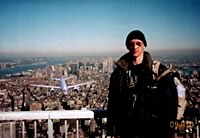 |
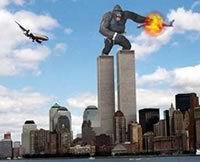 |
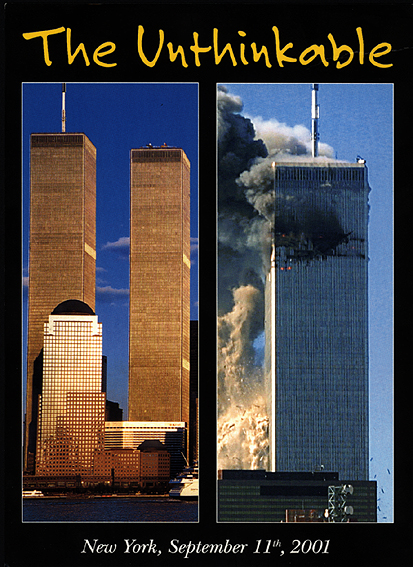
|
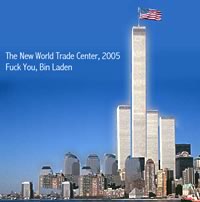 |
 |
 |
They are almost completely gone now, yet a few hours after the atrocious and spectacular event, anonymous hoaxers from around the world circulated dozens of jokes and digital images on the web that ironized the tragedy with greater or lesser wit: an absentminded tourist having his picture taken on top of one of the towers while one of the Boeings approaches from behind/ King Kong, mounted on the towers, catching one of the planes in mid air as the other plane flutters around him/ Spiderman wondering where the Towers had gone/ a new electronic version of the two magnificent buildings designed by an imaginary Mexican architect with two openings that would permit airplanes to pass through their structure without difficulty/ an enormous phallus-shaped construction replacing the old WTC and daringly presiding over New York/ New York's skyline in 2006 strewn with mosques/ A long Arab veil covering the face of the Statue of Liberty/ and, in the same vein, a whole flood of images (which are also commentaries and valid statements) in the midst of which one could see the grotesque scene of Bin Laden sodomizing a distressed President Bush.
As in a lavish Hollywood superproduction, digital technology made possible the cathartic or playful reconstruction of the urban landscape of the great city of glass and steel.
In their renowned book The Morning of the Magicians, Louis Pauwels and Jacques Bergier retell the story of a monk from the future, doing penitence in the desert, who finds a circuit diagram explaining the functioning of some archaic electronic device. He however thinks it is a sacred manuscript illustrated by a famous saint who lived before the nuclear holocaust and devotes himself to decorate it with calligraphy and traces of color.(2) We can imagine the amazement of the archaeologists of the future when they discover photographic evidence of the Twin Towers—for instance, the post cards of New York which were withdrawn from stores (3)—before and after the plane crash—i.e., the digital reconstructions—and conclude that there once existed a civilization capable of rising from the ashes. Or that in the end it disappeared having fallen victim to a devastating nuclear bombing, as is suggested in the last scene from The Planet of the Apes, in its first and unsurpassable version, when Charlton Heston stares in astonishment at the half-buried remains of the Statue of Liberty.
New York has been a legendary and universal city almost since its foundation. If the unbelievable terrorist attacks shocked almost everyone in the world, it was because New York had somewhat managed to "detach" itself from the US: not only is it one of the most important capitals of art, culture and finance, but it is the home of all the nationalities of the world, a melting pot where Italians, Irish, Jews, Latin-Americans, Africans and Asians thought they had found the best of all possible worlds. The city of Warhol and Rockefeller, of the Marx Brothers and Talking Heads. The prototypical city of the future, busy and optimistic, antithesis of the somber Los Angeles of Blade Runner. The city of all races and all people, as is proven by the sad fact that among those who died in the Twin Towers there were people from a hundred different countries.
Art and Memory
To perpetuate the memory of the disaster, several New York-based artists have come up with various suggestions. The sculptress Louis Bourgeois has proposed constructing on the ground once occupied by the towers a monument to the dead where their names would be inscribed. The conceptual artist Barbara Kruger has thought of the construction of a park around the remains of the structure of one of the towers. John Baldessari, on the other hand, proposes the construction of a park with two rectangular meadows indicating the place once occupied by the towers and planting in the adjacent area a number of trees equal to that of the victims; where the parking lot was located, he suggests building an amphitheater permanently displaying the faces of the people who died on September 11th. Several other artists, residents of the Lower Manhattan Cultural Council, which was located in Tower One, simply propose the virtual reconstruction of the buildings that formed the WTC.
A beautiful digital image appeared on the cover of several American and European magazines (El País Semanal, for example): the illuminated silhouette of New York stands out against a dark sky crossed by two towers of pure light disappearing into the skies. As we know, digital photography is a space where different times and places can come together naturally, as is the case of New York, timeless setting of traditions and cultures, both primitive and postmodern, in constant movement, cohabitation and renewal. Perhaps none of the virtual humorists have recreated New York after the attacks correctly: new towers or more mosques? It is conceivable that where the towers once stood a peaceful garden will be constructed honoring the memory of the six thousand citizens of the world that lived and worked in the legendary, endearing, dazzling city that never sleeps. Paradoxically, the towers will disappear from maps and from movies that have not been released, but they will continue to exist in the millions of digital copies that will travel the world, drawing a passing smile, a grimace of surprise, a nostalgic look.
Share your thoughts about this article with Rogelio Villarreal
1. Tzvetan Todorov, La conquista de América. El problema del otro, Mexico, Siglo XXI, 1995, pp. 82-83. [The Conquest of America: The Question of the Other, University of Oklahoma Press, 1999].
2. "Cántico a san Leibowitz", by Walter M. Miller, in El retorno de los brujos, Barcelona, Plaza y Janés, 1990, p. 265. [A Canticle for Leibowitz, Bantam Books, 1997].
3. Only to be rapidly replaced by postcards with the image of the Twin Towers before and during the plane crashes… The postcards are printed and distributed by City Merchandise and the proceedings, as can be read on the back, will be donated to the victims of the disaster.